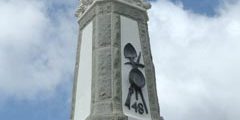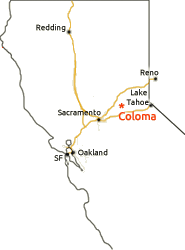
Noah Webster defined the word Providence to mean “foresight; timely care… foresight accompanied with the procurement of what is necessary for future use… the care and superintendence which God exercises over his creatures.” One key word in this definition is “timely”. In other words, God times events for His purposes, and California is such an example.
Though Natives discovered gold in 1841, nothing came of it. Though gold was again discovered in 1844, a misinterpretation of the Spanish language led to the abandonment of the enterprise. Why would years of inactivity “suddenly” occur, and gold “officially” discovered on January 24, 1848 in the little town of Coloma, become so significant? Hopefully, this history lesson provides a hint as to what God may have had in mind.
Every state that eventually became a part of the United States (as well as every nation) has its own providential history. California is certainly no exception to this truth. In 1602, after Pope Alexander VI divided the globe’s exploration between Spain and Portugal, many navigators and explorers found their way to the coast of California. However, 167 years of neglect and inactivity occured before Spain planted its Catholic mission towns in earnest. This time period allowed the English Colonies to develop its self-governing bottom-up type of government, unique in the world at the time, that defined the wealth of nations by what the individual owned rather than what the government owned. In essence, contrary to what Kings and Crowns stated, the colonies demonstrated that self-government could work.
T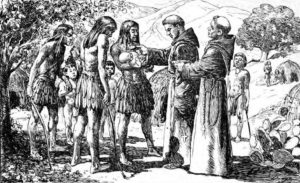 wenty Spanish missions were established in California by 1822 when Mexico revolted against Spain. The 21st and last mission was established in 1823. Mexico then secularized the missions by putting them under the control of civil administrators rather than the local Padres. The State-supported Catholic Church curtailed its missionary work by 1834. The top-down system of government suffocated the spiritual work of the missions and thus caused other activity lay dormant as well.
wenty Spanish missions were established in California by 1822 when Mexico revolted against Spain. The 21st and last mission was established in 1823. Mexico then secularized the missions by putting them under the control of civil administrators rather than the local Padres. The State-supported Catholic Church curtailed its missionary work by 1834. The top-down system of government suffocated the spiritual work of the missions and thus caused other activity lay dormant as well.
The Russians, who established a trading outpost for sea otter furs on the northern coast of California in 1812, withdrew their claims to the territory by 1841 due to the establishment of the Monroe Doctrine (1823.) This foreign policy statement said that once a nation had won its independence and maintained it (as Mexico had), any new encroachment by a foreign government outside this hemisphere would be viewed as a threat to the U.S. The Russian Orthodox Church, structured similarly to the Catholic Church under Spain, would no longer lay claim to California.
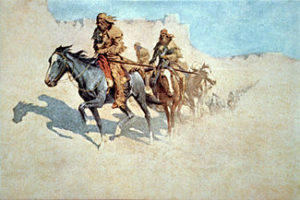
God appeared to be providentially providing the right structure of self-government before gold would be discovered and
made known publicly. Jedidiah Smith became the first “pathfinder” in 1826 to blaze an overland trail to California and Oregon. Wherever “Bible-toter Jed” set up camp, the “common law” found in the Bible would be followed, inspiring people to be governed within. His fifteen men and fifty horses brought the idea of self-government since there was no external civil government in force. They were followed by explorers and adventurers. Smith and others were representatives of a different philosophy of government based on the internal control of the individual through Christ and they set the standard for those who followed without such strong faith.
When war broke out with Mexico in 1846, the California settlers who were tired of Mexican harassment, led by Lt. Joseph Warren Revere, formed the Bear Flag Republic in Sonoma. After the war began, they lowered the Bear Flag and raised the American flag. The results of the Treaty of Hidalgo in 1848 ceded the province of Alto California to the United States along with other territories that would become three new states (Nevada, Utah, Arizona) and parts of three others (Wyoming, New Mexico, Colorado) – all west of what was claimed by Texas.
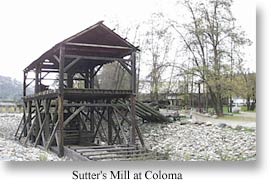 On May 28, 1847, John Sutter, a self-governed man filled with good character employed two millwrights, one of whom was John Marshall. Sutter was a productive individual who brought with him into the wilderness a solid work ethic. All of them built a “sawmill in the mountains” near Coloma. Not only did Sutter promise to pay Marshall for his work, but he also gave him an interest in the mill. This again demonstrates the unique nature of American economics built on biblical principles – for he didn’t hire merely an “employee” but rather an associate who would benefit from his own productivity.
On May 28, 1847, John Sutter, a self-governed man filled with good character employed two millwrights, one of whom was John Marshall. Sutter was a productive individual who brought with him into the wilderness a solid work ethic. All of them built a “sawmill in the mountains” near Coloma. Not only did Sutter promise to pay Marshall for his work, but he also gave him an interest in the mill. This again demonstrates the unique nature of American economics built on biblical principles – for he didn’t hire merely an “employee” but rather an associate who would benefit from his own productivity.
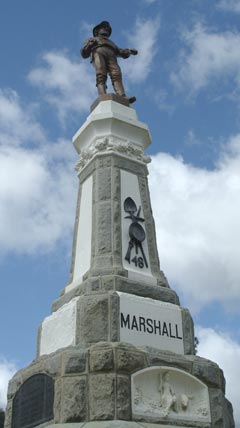
While doing his work on January 24, Marshall found particles of metal in the river bed. After showing it to Sutter, and thoroughly checking out the bulk of the alloy, it was determined to be gold. They tried to keep it quiet. However, several others who were working at the mill found out about it and “it spread like wildfire.” The discovery just about ruined the lives and businesses of both Sutter and Marshall. For a time, the madness was tempered by the fact that they knew those who came seeking fortunes. The “Gold Rush of 49”, though greatly enriching California with wealth, also saw greedy miners forcing their way on other’s lands.
In 1848 the population of California was about 15,000, but by 1852 – it reached 223,856. In 1848 alone over 10 million dollars of gold was mined by only 6,000 workers. By 1852, 80 million dollars came from 100,000 workers. The ratification by Congress of the State of California entering the Union in 1850 helped to bring order and restore local self-government. But what lessons can we learn today?
First, the right form of government (in America and California) insured that wealth would go to the individual. Second, real gold is to be found within the work ethic that built America; individual productivity. Finally, in order to have internal (Christian) and external (real wealth) “gold” today, we must restore individual self-government as the cornerstone of our spiritual and national life.

